Discover 35 hidden attractions, cool sights, and unusual things to do in Berlin (Germany). Don't miss out on these must-see attractions: Brandenburg Gate, Pergamon Museum, and Fernsehturm. Also, be sure to include Luftwaffenmuseum der Bundeswehr in your itinerary.
Below, you can find the list of the most amazing places you should visit in Berlin (Berlin).
Table of Contents
Brandenburg Gate
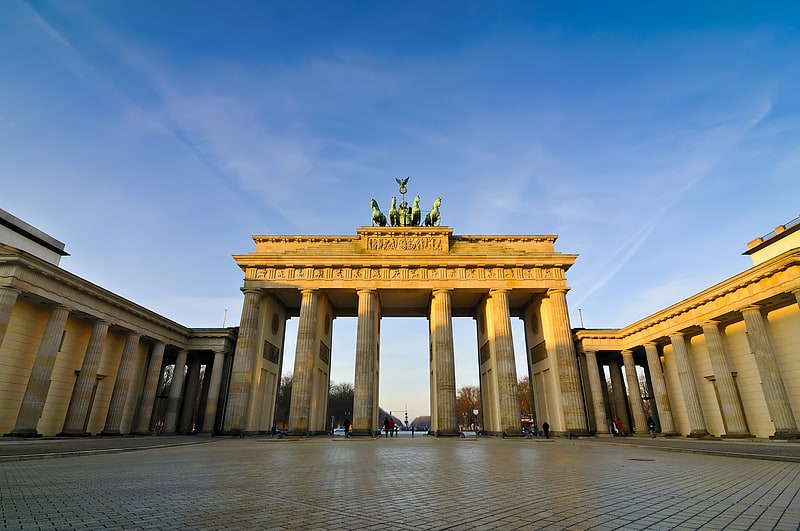
Also known as: Brandenburger Tor
Grand classical archway and city divide. The Brandenburg Gate is an 18th-century neoclassical monument in Berlin, built on the orders of Prussian king Frederick William II after the temporary restoration of order during the Batavian Revolution. One of the best-known landmarks of Germany, it was built on the site of a former city gate that marked the start of the road from Berlin to the town of Brandenburg an der Havel, which used to be the capital of the Margraviate of Brandenburg.
It is located in the western part of the city centre of Berlin within Mitte, at the junction of Unter den Linden and Ebertstraße, immediately west of the Pariser Platz. One block to the north stands the Reichstag building, which houses the German parliament (Bundestag). The gate is the monumental entry to Unter den Linden, a boulevard of linden trees which led directly to the royal City Palace of the Prussian monarchs.
Throughout its existence, the Brandenburg Gate was often a site for major historical events and is today considered not only as a symbol of the tumultuous histories of Germany and Europe, but also of European unity and peace.[1]
Address: Pariser Platz 7, 10117 Berlin (Mitte)
Pergamon Museum

Also known as: Pergamonmuseum
Antiquities and ancient art collections. The Pergamon Museum is a listed building on the Museum Island in the historic centre of Berlin, Germany. It was built from 1910 to 1930 by order of Emperor Wilhelm II according to plans by Alfred Messel and Ludwig Hoffmann in Stripped Classicism style. As part of the Museum Island complex, the Pergamon Museum was inscribed on the UNESCO World Heritage List in 1999 because of its architecture and testimony to the evolution of museums as architectural and social phenomena.
Currently, the Pergamon Museum is home to the Antikensammlung including the famous Pergamon Altar, the Vorderasiatisches Museum and the Museum für Islamische Kunst. Parts of the building are closed for renovation until 2025. As announced in the RBB24 news on March 27, 2023, the museum will completely close its doors for visitors from october 2023 on, at least until 2027 due to more comprehensive renovation works becoming necessary.[2]
Address: Bodestrasse 1-3, 10178 Berlin (Mitte)
Fernsehturm
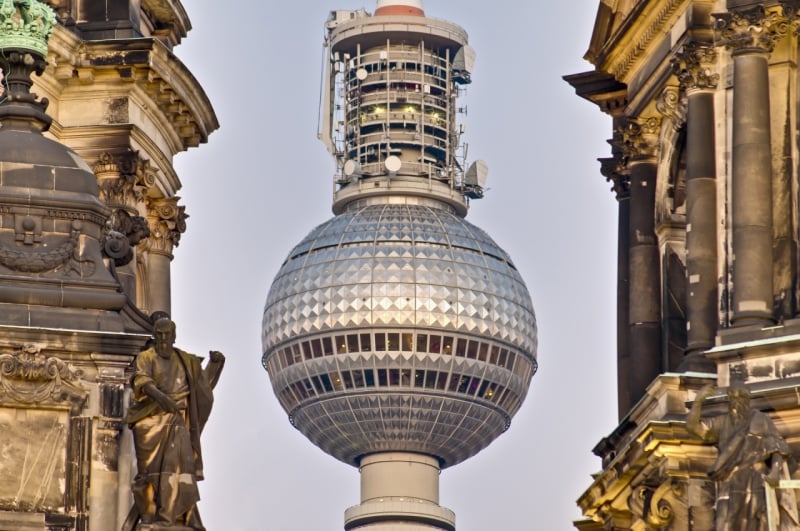
1960s architecture and a viewing platform. The Berliner Fernsehturm or Fernsehturm Berlin is a television tower in central Berlin, Germany.
Located in the Marien quarter (Marienviertel), close to Alexanderplatz in the locality and district of Mitte, the tower was constructed between 1965 and 1969 by the government of the German Democratic Republic (East Germany). It was intended to be both a symbol of Communist power and of the city. It remains a landmark today, visible throughout the central and some suburban districts of Berlin. With its height of 368 metres (including antenna) it is the tallest structure in Germany, and the third-tallest structure in the European Union. When built it was the fourth-tallest freestanding structure in the world after the Ostankino Tower, the Empire State Building and 875 North Michigan Avenue, then known as The John Hancock Center.
Of the four tallest structures in Europe, it is 2 m shorter than the Torreta de Guardamar, 0.5 m shorter than the Riga Radio and TV Tower, and 8 m taller than the Trbovlje Power Station in 2017. The structure is also more than 220 metres higher than the old Berlin Radio Tower in the western part of the city, which was built in the 1920s.
In addition to its main function as the location of several radio and television broadcasting stations, the building – internally known as "Fernmeldeturm 32" – serves as a viewing tower with observation deck including a bar at a height of 203 metres, as well as a rotating restaurant. Also, the Berlin TV Tower can be booked as a venue for events. The distinctive city landmark has undergone a radical, symbolic transformation: After German reunification, it changed from a politically charged, national symbol of the GDR into a citywide symbol of a reunited Berlin. Due to its universal and timeless design, it has increasingly been used as a trademark and is identified worldwide with Berlin and Germany. In 1979, the Berlin TV Tower received monument status by the GDR, a status which was perpetuated after the German reunification.
The tower has become one of the most prominent symbols of the country and is often in the establishing shot of films set in Berlin, alongside monuments such as the Brandenburg Gate, the Berlin Victory Column and the Reichstag building. It is also one of the ten most popular attractions in Germany with more than 1,000,000 visitors every year.[3]
Address: Panoramastraße 1A, 10178 Berlin (Mitte)
Luftwaffenmuseum der Bundeswehr
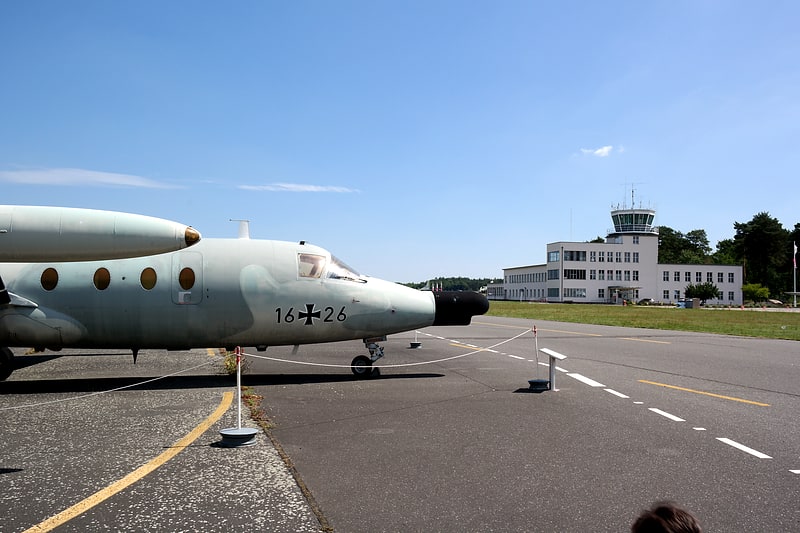
Also known as: Militärhistorisches Museum Flugplatz Berlin-Gatow
Historic military aircraft collection. The Militärhistorisches Museum der Bundeswehr – Flugplatz Berlin-Gatow, is the Berlin branch of the Bundeswehr Military History Museum. The museum acts as an independent military department.
The museum is in Berlin at a former Luftwaffe and Royal Air Force (RAF) airfield, RAF Gatow. The focus is on military history, particularly the history of the post-war German Air Force. The museum has a collection of more than 200,000 items, including 155 aeroplanes, 5,000 uniforms and 30,000 books. There are also displays (including aeroplanes) on the history of the airfield when it was used by the RAF.
Aircraft include World War I planes such as the Fokker E.III as reproductions, and World War II planes such as the Bf 109, as well as at least one aircraft of every type ever to serve in the air forces of East and West Germany. Most of those postwar aircraft are stored outside on the tarmac and runways, however, and many are in bad condition. There are long term restoration projects, including a Focke-Wulf Fw 190. Because of that the museum is under construction, some exhibits can shortly removed for restoration, repainting or lending to other museums.[4]
Address: Am Flugplatz Gatow 33, 14089 Berlin (Spandau)
Memorial to the Murdered Jews of Europe
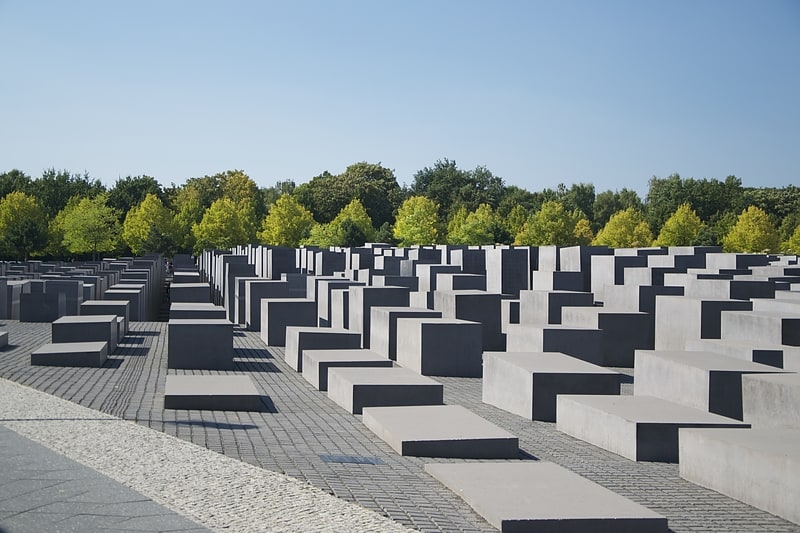
Also known as: Denkmal für die ermordeten Juden Europas
Museum in Berlin, Germany. The Memorial to the Murdered Jews of Europe, also known as the Holocaust Memorial, is a memorial in Berlin to the Jewish victims of the Holocaust, designed by architect Peter Eisenman and engineer Buro Happold. It consists of a 19,000-square-metre site covered with 2,711 concrete slabs or "stelae", arranged in a grid pattern on a sloping field. The original plan was to place nearly 4,000 slabs, but after the recalculation, the number of slabs that could legally fit into the designated areas was 2,711. The stelae are 2.38 m long, 0.95 m wide and vary in height from 0.2 to 4.7 metres. They are organized in rows, 54 of them going north–south, and 87 heading east–west at right angles but set slightly askew. An attached underground "Place of Information" holds the names of approximately 3 million Jewish Holocaust victims, obtained from the Israeli museum Yad Vashem.
Building began on 1 April 2003, and was finished on 15 December 2004. It was inaugurated on 10 May 2005, sixty years after the end of World War II in Europe, and opened to the public two days later. It is located one block south of the Brandenburg Gate, in the Mitte neighborhood. The cost of construction was approximately €25 million.[5]
Address: Cora-Berliner-Straße 1, 10117 Berlin (Mitte)
Potsdamer Platz
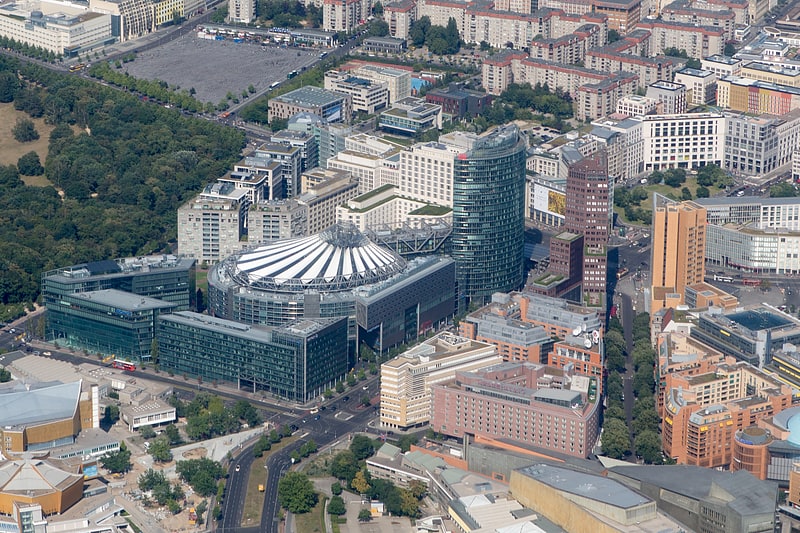
Square at the heart of city's history. Potsdamer Platz is a public square and traffic intersection in the center of Berlin, Germany, lying about 1 km south of the Brandenburg Gate and the Reichstag, and close to the southeast corner of the Tiergarten park. It is named after the city of Potsdam, some 25 km to the south west, and marks the point where the old road from Potsdam passed through the city wall of Berlin at the Potsdam Gate. After developing within the space of little over a century from an intersection of rural thoroughfares into the most bustling traffic intersection in Europe, it was totally destroyed during World War II and then left desolate during the Cold War era when the Berlin Wall bisected its former location. Since German reunification, Potsdamer Platz has been the site of major redevelopment projects.[6]
Address: Potsdamer Platz, 10785 Berlin (Mitte)
East Side Gallery
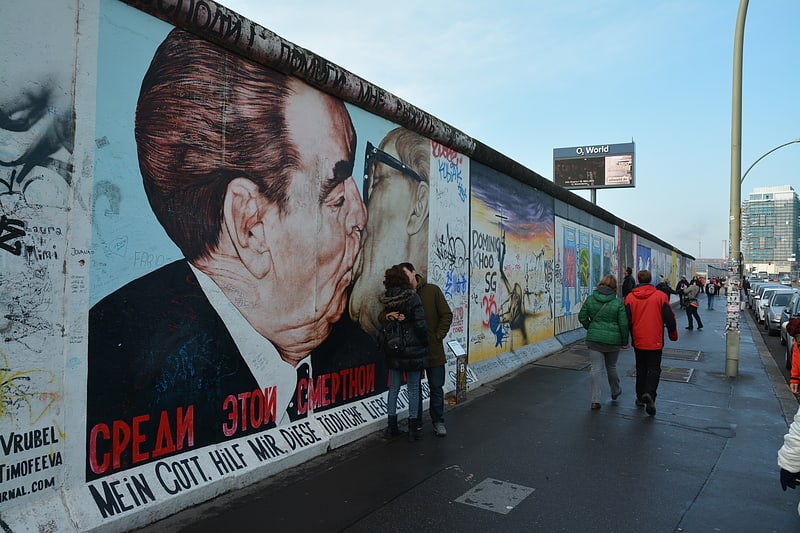
Section of Berlin Wall for street art. The East Side Gallery memorial in Berlin-Friedrichshain is a permanent open-air gallery on the longest surviving section of the Berlin Wall in Mühlenstraße between the Berlin Ostbahnhof and the Oberbaumbrücke along the Spree. It consists of a series of murals painted directly on a 1,316 m long remnant of the Berlin Wall, located near the centre of Berlin, on Mühlenstraße in Friedrichshain-Kreuzberg.
In the spring of 1990, after the opening of the Berlin Wall, this section was painted by 118 artists from 21 countries. The artists commented on the political changes of 1989/90 in a good hundred paintings on the side of the Wall that was formerly facing East Berlin. Due to urban development measures, it is no longer completely preserved, and instead of the originals from then, only the replicas from 2009 exist today.
The actual border at this point was the Kreuzberg bank of the Spree. The gallery is located on the so-called hinterland wall, which closed off the border area to East Berlin. Mühlenstrasse, one of the main arterial roads to the south, ran along these border installations. Due to the spatial conditions, the previously usual concrete pipes were already installed here, so that the interior wall in this area was atypically optically, but somewhat elevated, resembling the outer wall.
The gallery has official status as a Denkmal, or heritage-protected landmark. According to the Künstlerinitiative East Side Gallery e.V., an association of the artists involved in the project, "The East Side Gallery is understood as a monument to the fall of the Berlin Wall and the peaceful negotiation of borders and conventions between societies and people", and has more than three million visitors per year.[7]
Address: Mühlenstraße 3-100, 10243 Berlin (Friedrichshain-Kreuzberg)
German Museum of Technology
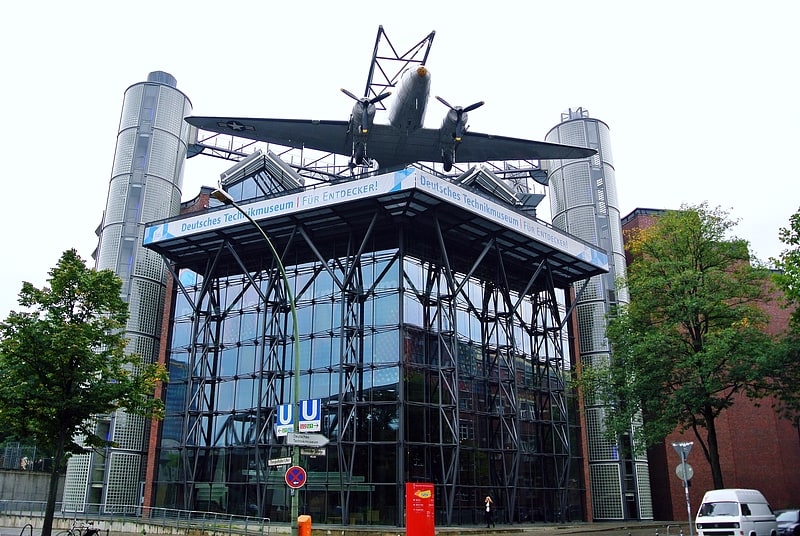
Also known as: Stiftung Deutsches Technikmuseum Berlin
Museum of vehicles, science and technology. Deutsches Technikmuseum Berlin in Berlin, Germany is a museum of science and technology, and exhibits a large collection of historical technical artifacts. The museum's main emphasis originally was on rail transport, but today it also features exhibits of various sorts of industrial technology. In 2003, it opened both maritime and aviation exhibition halls in a newly built extension. The museum also contains a science center called Spectrum.[8]
Address: Trebbiner Str. 9, 10963 Berlin (Friedrichshain-Kreuzberg)
Zoo Berlin
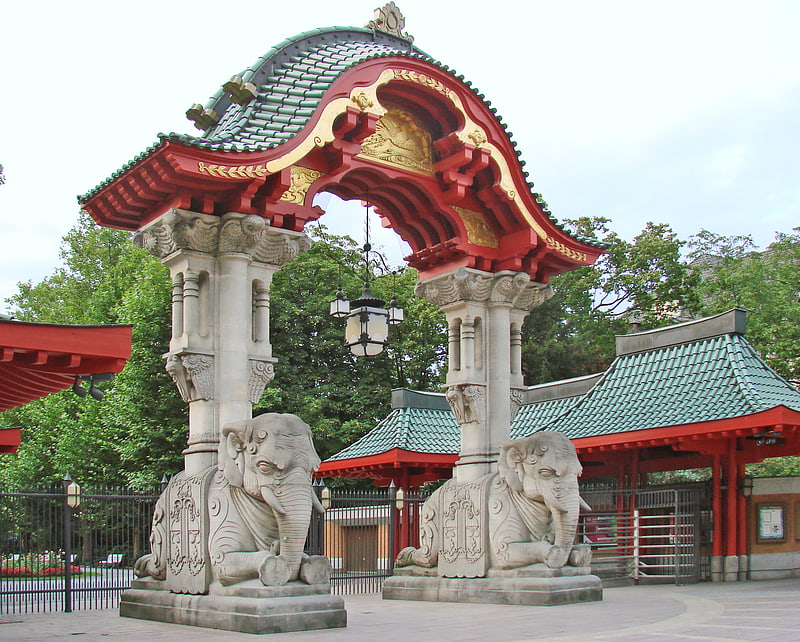
Also known as: Zoologischer Garten Berlin
Huge, leafy zoo with modern aviary. The Berlin Zoological Garden is the oldest surviving and best-known zoo in Germany. Opened in 1844, it covers 35 hectares and is located in Berlin's Tiergarten. With about 1,380 different species and over 20,200 animals, the zoo presents one of the most comprehensive collections of species in the world.
The zoo and its aquarium had more than 3.5 million visitors in 2017. It is the most-visited zoo in Europe and one of the most popular worldwide. Regular animal feedings are among its most famous attractions. Globally known animals like Knut, the polar bear, and Bao Bao, the giant panda have contributed to the zoo's public image.
The zoo collaborates with many universities, research institutes, and other zoos around the world. It maintains and promotes European breeding programmes, helps safeguard several endangered species, and participates in several species reintroduction programs.[9]
Address: Hardenbergplatz 8, 10787 Berlin (Mitte)
Topography of Terror
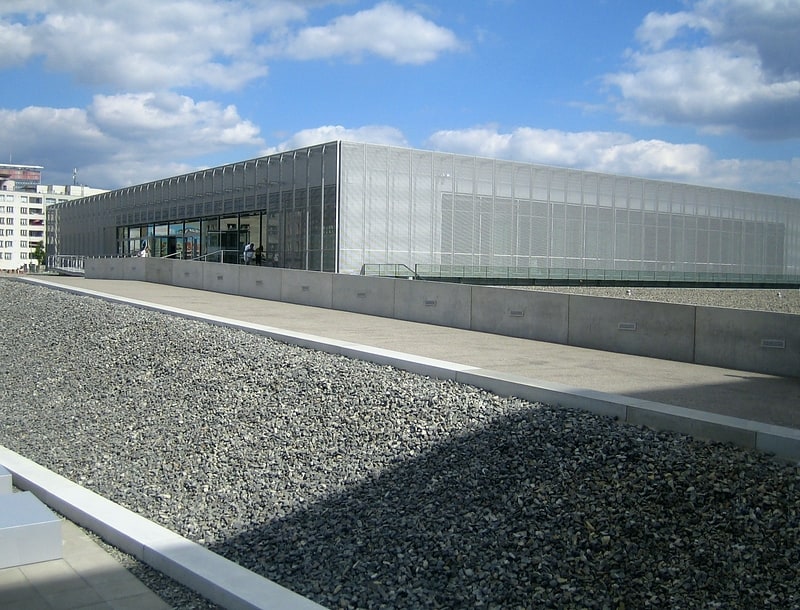
Also known as: Topographie des Terrors
Center documenting Nazi atrocities. The Topography of Terror is an outdoor and indoor history museum in Berlin, Germany. It is located on Niederkirchnerstrasse, formerly Prinz-Albrecht-Strasse, on the site of buildings, which during the Nazi regime from 1933 to 1945 was the SS Reich Security Main Office, the headquarters of the Sicherheitspolizei, SD, Einsatzgruppen and Gestapo.
The buildings that housed the Gestapo and SS headquarters were largely destroyed by Allied bombing during early 1945 and the ruins demolished after the war. The boundary between the American and Soviet zones of occupation in Berlin ran along the Prinz-Albrecht-Strasse, so the street soon became a fortified boundary, and the Berlin Wall ran along the south side of the street, renamed Niederkirchnerstrasse, from 1961 to 1989. The wall here was never demolished. The section adjacent to the Topography of Terror site is the longest extant segment of the outer wall, as the longer East Side Gallery section in Friedrichshain was part of the inner wall, not visible from West Berlin.
The first exhibitions of the site took place in 1987, as part of Berlin's 750th anniversary. The cellar of the Gestapo headquarters, where many political prisoners were tortured and executed, was found and excavated. The site was then turned into a memorial and museum, in the open air but protected from the elements by a canopy, detailing the history of repression under the Nazis. The excavation took place in cooperation with East German researchers, and a joint exhibition was shown both at the site and in East Germany in 1989.
In 1992, two years after German reunification, a foundation was established to take care of the site, and the following year, it initiated an architectural competition to design a permanent museum. A design by architect Peter Zumthor was chosen. However, construction was stopped due to funding problems after the concrete core of the structure had been built. This stood on the site for nearly a decade until it was finally demolished in 2004 and a new building begun.
The construction of the new Documentation Centre according to a prize-winning design by the architect Ursula Wilms (Heinle, Wischer und Partner, Berlin) and the landscape architect Heinz W. Hallmann (Aachen) was finished in 2010. The new Documentation Centre was officially opened on 6 May 2010 by Federal President Horst Köhler on the occasion of the 65th anniversary of the end of World War II. The new exhibition and documentation building and the redesigned historic grounds were opened to the public on 7 May 2010.[10]
Address: Niederkirchnerstraße 8, 10963 Berlin (Friedrichshain-Kreuzberg)
Berlin Cathedral
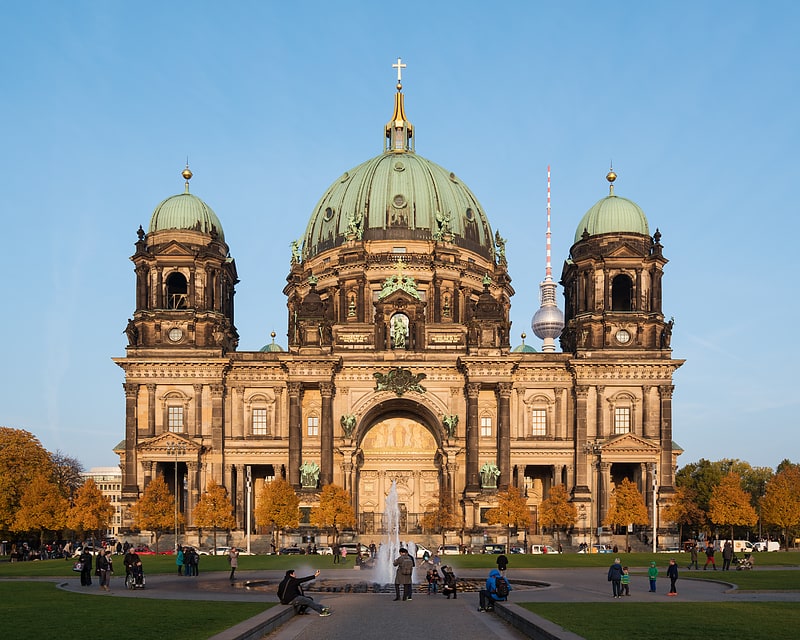
Also known as: Berliner Dom
Elaborate 19th-century cathedral. The Berlin Cathedral, also known as, the Evangelical Supreme Parish and Collegiate Church, is a monumental German Evangelical church and dynastic tomb on the Museum Island in central Berlin. Having its origins as a castle chapel for the Berlin Palace, several structures have served to house the church since the 1400s. The present collegiate church was built from 1894 to 1905 by order of German Emperor William II according to plans by Julius Raschdorff in Renaissance and Baroque Revival styles. The listed building is the largest Protestant church in Germany and one of the most important dynastic tombs in Europe. In addition to church services, the cathedral is used for state ceremonies, concerts and other events.
Since the demolition of the Memorial Church (Denkmalskirche) section on the north side by the East German authorities in 1975, the Berlin Cathedral has consisted of the large Sermon Church (Predigtkirche) in the center, and the smaller Baptismal and Matrimonial Church (Tauf- und Traukirche) on the south side and the Hohenzollern crypt (Hohenzollerngruft), which covers almost the entire basement. Damaged during the Allied bombing in World War II, the cathedral’s original interior was restored by 2002. Currently there is discussion about restoring the historical exterior as well.[11]
Address: Am Lustgarten, 10178 Berlin (Mitte)
Jewish Museum
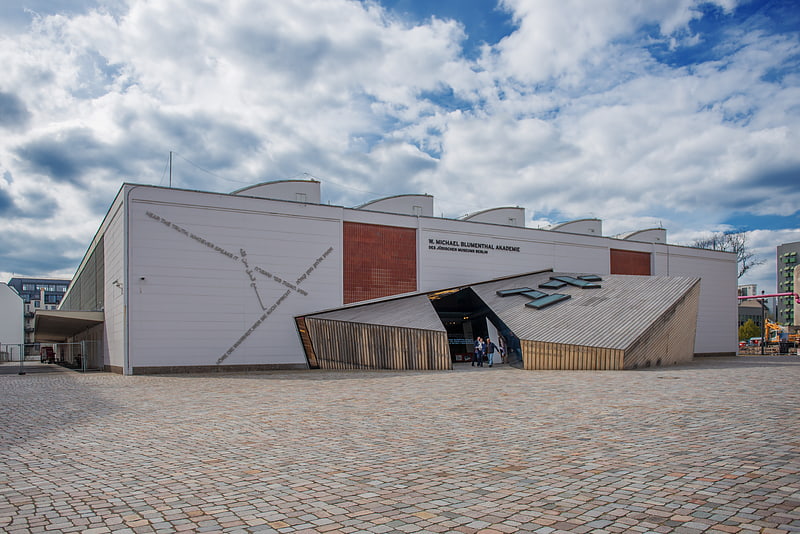
Also known as: Jüdisches Museum Berlin
German-Jewish history and culture. The Jewish Museum Berlin was opened in 2001 and is the largest Jewish museum in Europe. On 3,500 square metres of floor space, the museum presents the history of Jews in Germany from the Middle Ages to the present day, with new focuses and new scenography. It consists of three buildings, two of which are new additions specifically built for the museum by architect Daniel Libeskind. German-Jewish history is documented in the collections, the library and the archive, and is reflected in the museum's program of events.
From its opening in 2001 to December 2017, the museum had over eleven million visitors and is one of the most visited museums in Germany.
Opposite the building ensemble, the W. Michael Blumenthal Academy of the Jewish Museum Berlin was built – also after a design by Libeskind – in 2011/2012 in the former flower market hall. The archives, library, museum education department, a lecture hall and the Diaspora Garden can all be found in the academy.[12]
Address: Lindenstraße 9-14, 10969 Berlin (Friedrichshain-Kreuzberg)
Checkpoint Charlie
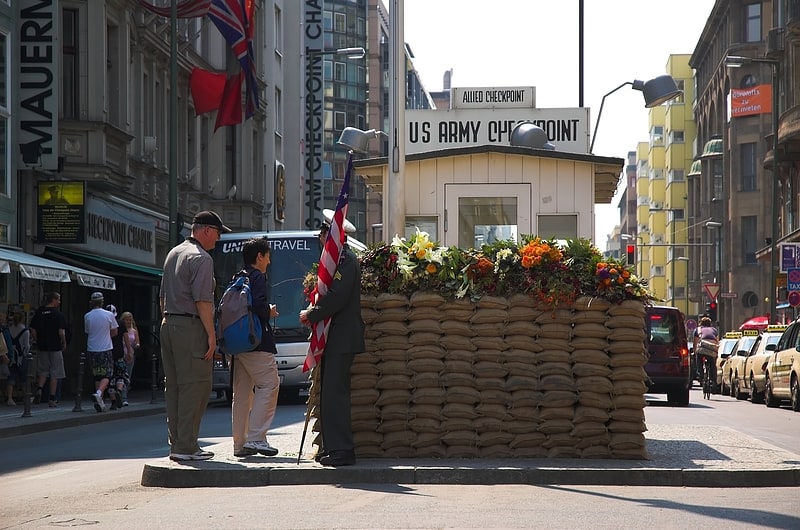
Cold war and east-west border landmark. Checkpoint Charlie was the best-known Berlin Wall crossing point between East Berlin and West Berlin during the Cold War, as named by the Western Allies.
East German leader Walter Ulbricht agitated and maneuvered to get the Soviet Union's permission to construct the Berlin Wall in 1961 to stop emigration and defection westward through the Border system, preventing escape across the city sector border from East Berlin into West Berlin. Checkpoint Charlie became a symbol of the Cold War, representing the separation of East and West. Soviet and American tanks briefly faced each other at the location during the Berlin Crisis of 1961. On June 26, 1963, U.S. President John F. Kennedy visited Checkpoint Charlie and looked from a platform onto the Berlin Wall and into East Berlin.
After the dissolution of the Eastern Bloc and the reunification of Germany, the building at Checkpoint Charlie became a tourist attraction. It is now located in the Allied Museum in the Dahlem neighborhood of Berlin.[13]
Address: Friedrichstraße 43-45, 10117 Berlin (Friedrichshain-Kreuzberg)
Bode Museum
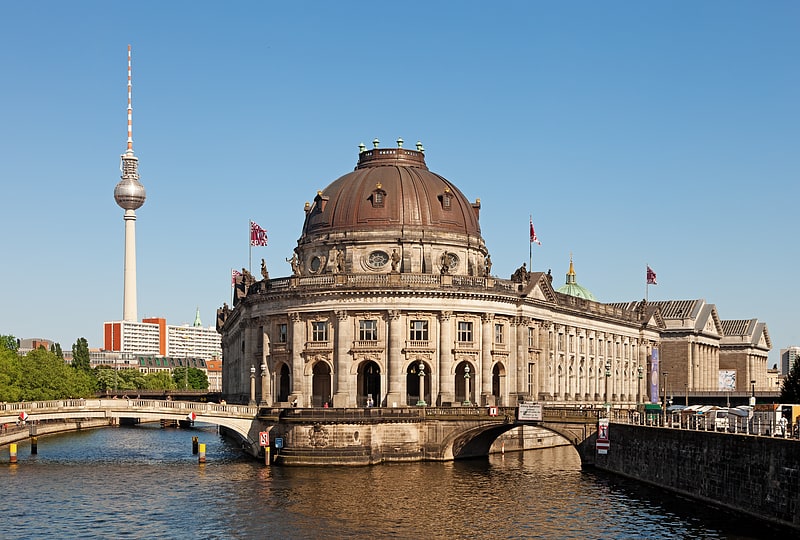
Also known as: Bode-Museum
Sculpture and Byzantine art collections. The Bode-Museum, formerly called the Kaiser-Friedrich-Museum, is a listed building on the Museum Island in the historic centre of Berlin and part of the UNESCO World Heritage. It was built from 1898 to 1904 by order of German Emperor William II according to plans by Ernst von Ihne in Baroque Revival style. The building's front square featured a memorial to German Emperor Frederick III, which was destroyed by the East German authorities. Currently, the Bode-Museum is home to the Skulpturensammlung, the Museum für Byzantinische Kunst and the Münzkabinett.[14]
Address: Am Kupfergraben, 10117 Berlin (Mitte)
Altes Museum
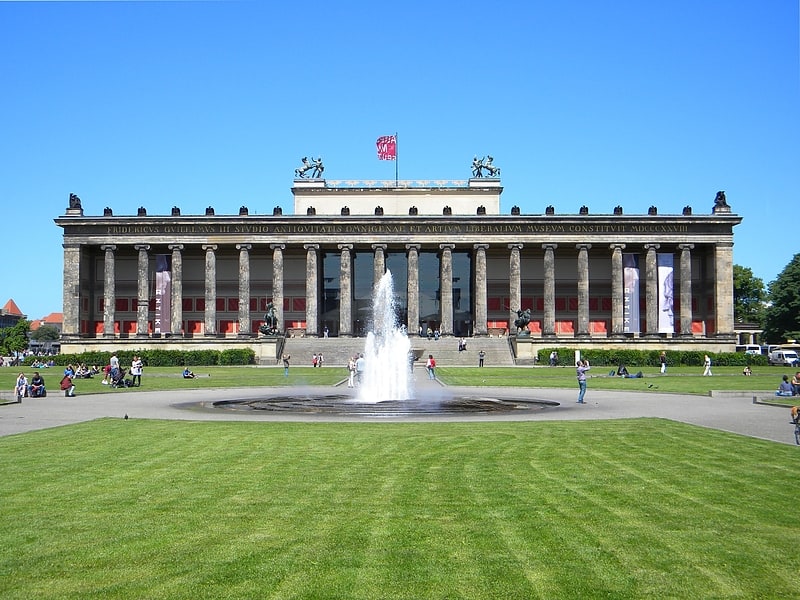
Displays of Greek and Roman artifacts. The Altes Museum is a listed building on the Museum Island in the historic centre of Berlin and part of the UNESCO World Heritage. Built from 1825 to 1830 by order of King Frederick William III of Prussia according to plans by Karl Friedrich Schinkel, it is considered as a major work of German Neoclassical architecture. It is surrounded by the Berlin Cathedral to the east, the Berlin Palace to the south and the Zeughaus to the west. Currently, the Altes Museum is home to the Antikensammlung and parts of the Münzkabinett.[15]
Address: Bodestraße 1-3, 10178 Berlin (Mitte)
Pariser Platz
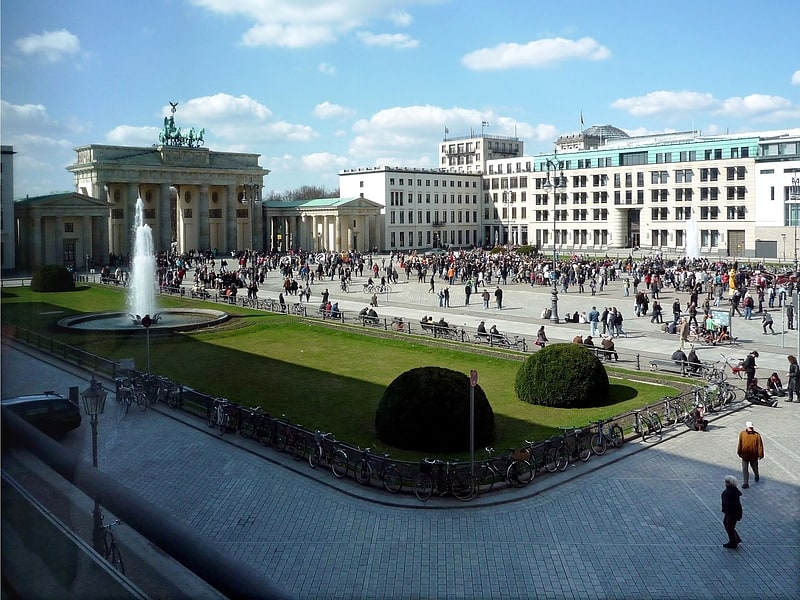
Historical landmark in Berlin, Germany. Pariser Platz is a square in the historic center of Berlin, Germany, situated by the Brandenburg Gate at the end of the Unter den Linden. The square is named after the French capital of Paris to commemorate the anti-Napoleon Allies' victory at the Battle of Paris, and is one of the main focal points of the city.[16]
Address: Pariser Platz, 10117 Berlin (Mitte)
Soviet War Memorial
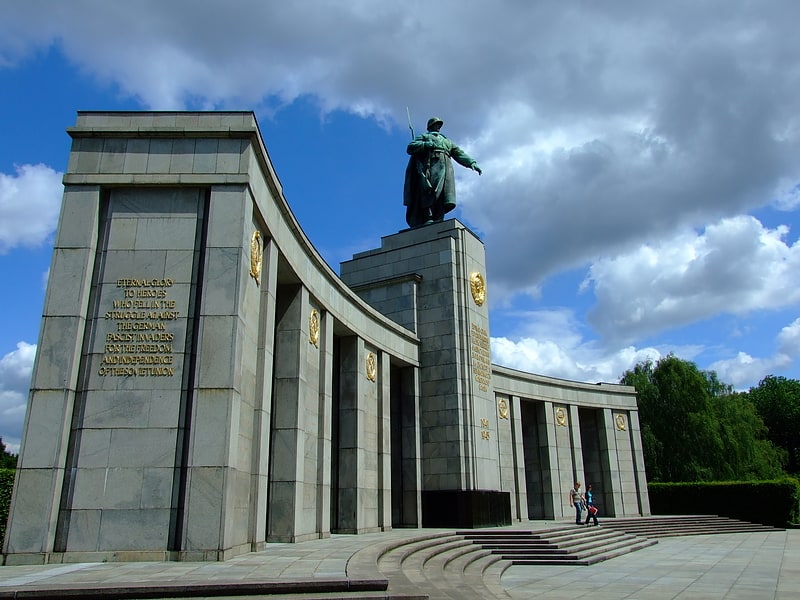
Also known as: Sowjetisches Ehrenmal
Soviet war memorial with artillery. The Soviet War Memorial is one of several war memorials in Berlin, the capital city of Germany, erected by the Soviet Union to commemorate its war dead, particularly the 80,000 soldiers of the Soviet Armed Forces who died during the Battle of Berlin in April and May 1945.
The memorial is located in the Großer Tiergarten, a large public park to the west of the city centre, on the north side of the east-west Straße des 17. Juni (17 June Street) in the Tiergarten locality.[17]
Address: Strasse des 17. Juni 100, 10557 Berlin (Mitte)
Neue Nationalgalerie
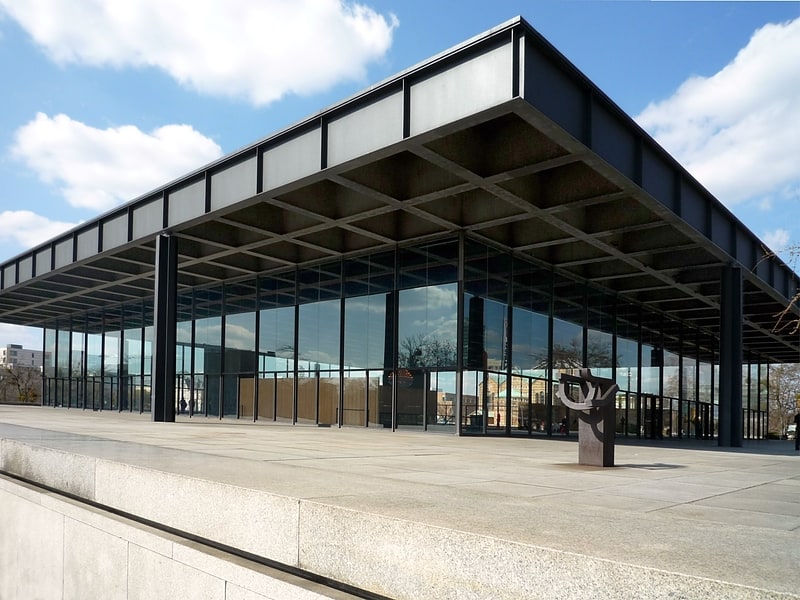
Museum in Berlin, Germany. The Neue Nationalgalerie at the Kulturforum is a museum for modern art in Berlin, with its main focus on the early 20th century. It is part of the National Gallery of the Berlin State Museums. The museum building and its sculpture gardens were designed by Ludwig Mies van der Rohe and opened in 1968.
The gallery closed in 2015 for renovation. The work, by David Chipperfield Architects, was completed in 2021, and the museum reopened in August 2021 with an exhibition of works by American sculptor Alexander Calder.[18]
Address: Potsdamer Straße 50, 10785 Berlin (Mitte)
Tiergarten Park
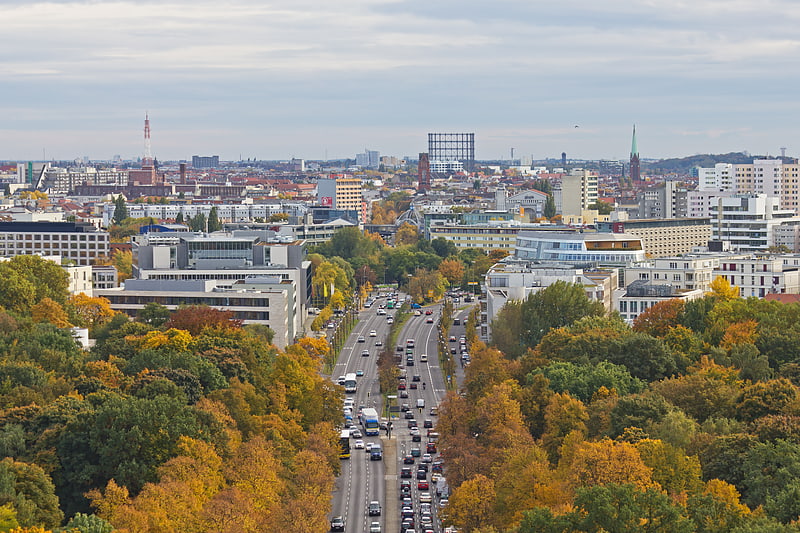
Also known as: Großer Tiergarten
Public park on an old hunting reserve. The Tiergarten is Berlin’s most popular inner-city park, located completely in the district of the same name. The park is 210 hectares in size and is among the largest urban gardens of Germany. Only the Tempelhofer Park and Munich's Englischer Garten are larger.[19]
Address: Str. des 17. Juni, 10785 Berlin (Mitte)
Neues Museum
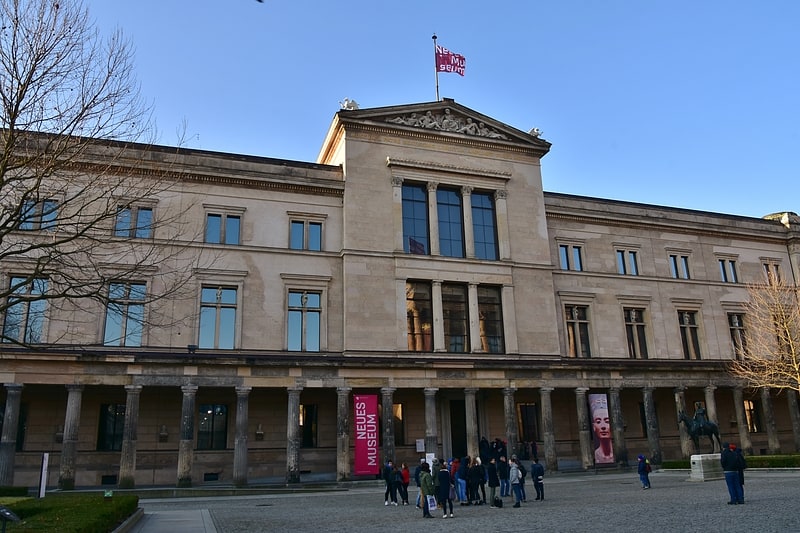
Museum of ancient art and archaeology. The Neues Museum is a listed building on the Museum Island in the historic centre of Berlin and part of the UNESCO World Heritage Site. Built from 1843 to 1855 by order of King Frederick William IV of Prussia in Neoclassical and Renaissance Revival styles, it is considered as the major work of Friedrich August Stüler. After suffering damage in World War II and decay in East Germany, it was restored from 1999 to 2009 by David Chipperfield. Currently, the Neues Museum is home to the Ägyptisches Museum, the Papyrussammlung, the Museum für Vor- und Frühgeschichte and parts of the Antikensammlung.[20]
Address: Bodestraße 1-3, 10178 Berlin (Mitte)
Lustgarten
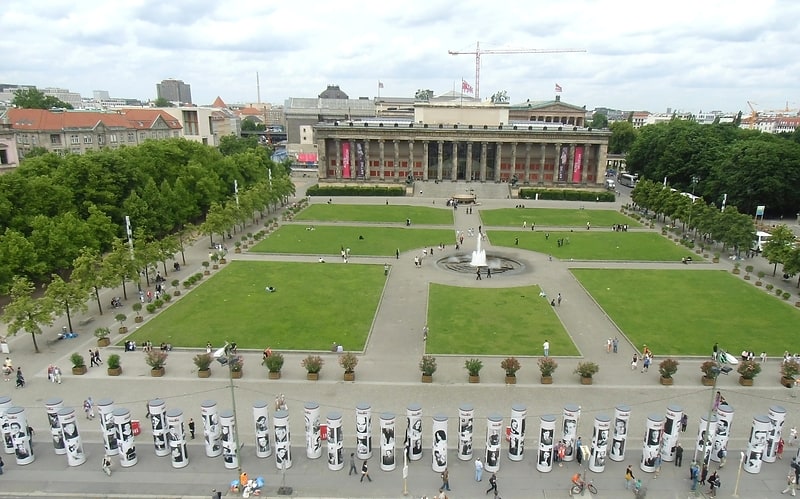
Public park with lawns and fountains. The Lustgarten is a park on Museum Island in central Berlin, near the site of the former Berliner Stadtschloss of which it was originally a part. At various times in its history, the park has been used as a parade ground, a place for mass rallies and a public park.
The area of the Lustgarten was originally developed in the 16th century as a kitchen garden attached to the Palace, then the residence of the Elector of Brandenburg, the core of the later Kingdom of Prussia. After the devastation of Germany during the Thirty Years War, Berlin was redeveloped by Friedrich Wilhelm (the Great Elector) and his Dutch wife, Luise Henriette of Nassau. It was Luise, with the assistance of a military engineer Johann Mauritz and a landscape gardener Michael Hanff, who, in 1646, converted the former kitchen garden into a formal garden, with fountains and geometric paths, and gave it its current name.
In 1713, Friedrich Wilhelm I became King of Prussia and set about converting Prussia into a militarised state. He ripped out his grandmother's garden and converted the Lustgarten into a sand-covered parade ground: Pariser Platz near the Brandenburg Gate and Leipziger Platz were also laid out as parade grounds at this time. In 1790, Friedrich Wilhelm II allowed the Lustgarten to be turned back into a park, but during French occupation of Berlin in 1806 Napoleon again drilled troops there.
In the early 19th century, the enlarged and increasingly wealthy Kingdom of Prussia undertook major redevelopments of central Berlin. A large, new classical building, the Old Museum, was built at the north-western end of the Lustgarten by the leading architect, Karl Friedrich Schinkel, and between 1826 and 1829 the Lustgarten was redesigned by Peter Joseph Lenné, with formal paths dividing the park into six sectors. A 13-metre high fountain in the centre, operated by a steam engine, was one of the marvels of the age. In 1871, the fountain was replaced by a large equestrian statue of Friedrich Wilhelm III by Albert Wolff. The statue was unveiled on 16 June 1871. Between 1894 and 1905, the old Protestant church on the northern side of the park was replaced by a much larger building, the Berlin Cathedral (in German, "Berliner Dom"), designed by Julius Carl Raschdorff.
During the years of the Weimar Republic, the Lustgarten was frequently used for political demonstrations. The Socialists and Communists held frequent rallies there. In August 1921, 500,000 people demonstrated against right-wing extremist violence. After the murder of Foreign Minister Walther Rathenau, on 25 June 1922, 250,000 protested in the Lustgarten. On 7 February 1933, 200,000 people demonstrated against the new Nazi Party regime of Adolf Hitler: shortly afterwards public opposition to the regime was banned. Under the Nazis, the Lustgarten was converted into a site for mass rallies. In 1934, it was paved over and the equestrian statue removed. Hitler addressed mass rallies of up to a million people there.
On 18 May 1942 a resistance group led by Herbert Baum consisting mainly of Jewish men and women, tried to destroy a propaganda exhibition The Soviet Paradise in the Lustgarten. This resulted in the discovery of the group, the death of Baum in Gestapo detention and the execution of at least 27 members of the group. In a "retaliation action," the Reich Security Main Office arrested 500 Jewish men at the end of May, and immediately murdered half of them. A memorial stone made by Jürgen Raue installed in 1981 commemorates the resistance group.
In 1944 the statue of Friedrich Wilhelm III by Albert Wolff was melted down to reuse the metal in war production.
By the end of World War II in 1945, the Lustgarten was a bomb-pitted wasteland. The German Democratic Republic left Hitler's paving in place, but planted lime trees around the parade ground to reduce its militaristic appearance. The whole area was renamed Marx-Engels-Platz. The City Palace was demolished and later replaced by the modernist Palace of the Republic on part of the site.
A movement to restore the Lustgarten to its earlier role as a park began once Germany was reunified in 1990. In 1997, the Berlin Senate commissioned the landscape architect Hans Loidl to redesign the area in the spirit of Lenné's design and construction work began in 1998. The Lustgarten now features fountains and is once again a park in the heart of a reunited Berlin.[21]
Address: Am Lustgarten 1, 10178 Berlin (Mitte)
Humboldt Box
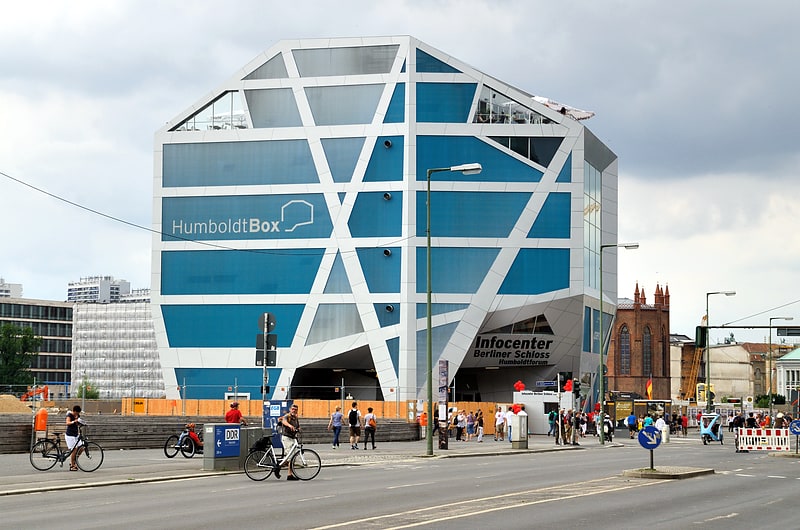
Also known as: Humboldt-Box
Museum in Berlin, Germany. The Humboldt Box was a futuristic museum structure on the Schloßplatz in the center of Berlin, Germany. It was built as a temporary exhibition space and viewing platform for the Humboldt Forum construction project and to inform the public about its future use.[22]
Address: Berlin, Schloßplatz
Soviet War Memorial
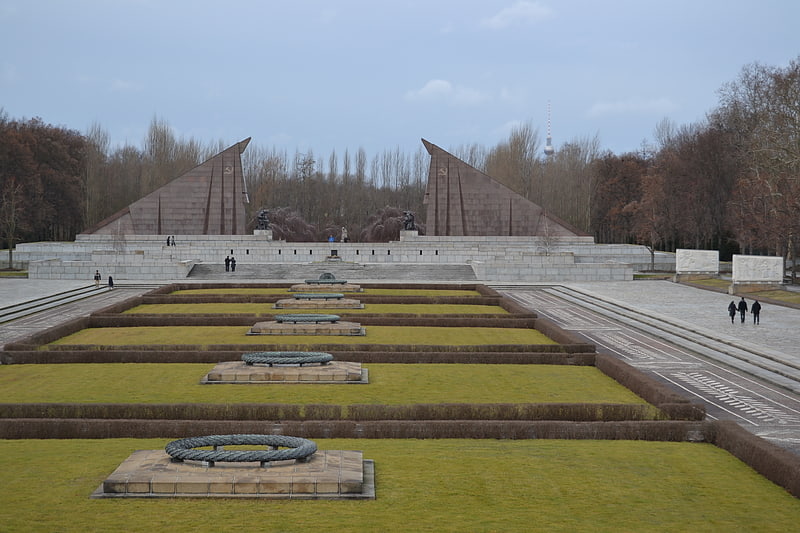
Also known as: Sowjetisches Ehrenmal im Treptower Park
Monumental tribute to Soviet military. The Soviet War Memorial is a war memorial and military cemetery in Berlin's Treptower Park. It was built to the design of the Soviet architect Yakov Belopolsky to commemorate 7,000 of the 80,000 Red Army soldiers who fell in the Battle of Berlin in April–May 1945. It opened four years after the end of World War II in Europe, on May 8, 1949. The Memorial served as the central war memorial of East Germany.
The monument is one of three Soviet memorials built in Berlin after the end of the war. The other two memorials are the Tiergarten memorial, built in 1945 in the Tiergarten district of what later became West Berlin, and the Schönholzer Heide Memorial in Berlin's Pankow district.
Together with the Rear-front Memorial in Magnitogorsk and The Motherland Calls in Volgograd, the monument is a part of a triptych.[23]
Address: Treptower Park, 10117 Berlin (Treptow-Köpenick)
Platz des 18. März

The Platz des 18. März is a public square in Berlin-Mitte located immediately west of the Brandenburg Gate, opposite Pariser Platz, at the junction of Ebertstraße and Straße des 17. Juni.[24]
Berlin Victory Column
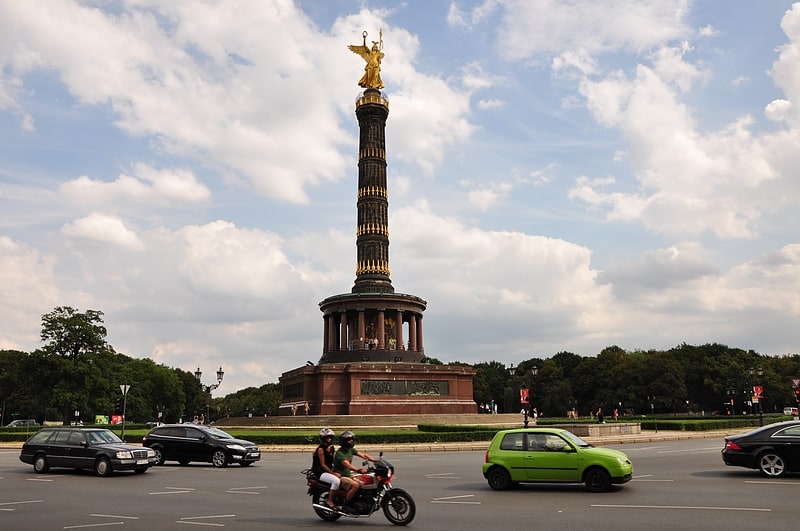
Also known as: Berliner Siegessäule
City-wide views from landmark column. The Victory Column is a monument in Berlin, Germany. Designed by Heinrich Strack after 1864 to commemorate the Prussian victory in the Second Schleswig War, by the time it was inaugurated on 2 September 1873, Prussia had also defeated Austria and its German allies in the Austro-Prussian War and France in the Franco-Prussian War, giving the statue a new purpose. Different from the original plans, these later victories in the unification wars inspired the addition of the bronze sculpture of Victoria, the Roman goddess of victory, 8.3 metres high, designed by Friedrich Drake.
Berliners have given the statue the nickname Goldelse, meaning something like "Golden Lizzy". The Victory Column is a major tourist attraction in the city of Berlin. Its viewing platform, for which a ticket is required, offers a view over Berlin.[25]
Address: Grosser Stern 1, 10557 Berlin (Mitte)
Reichstag
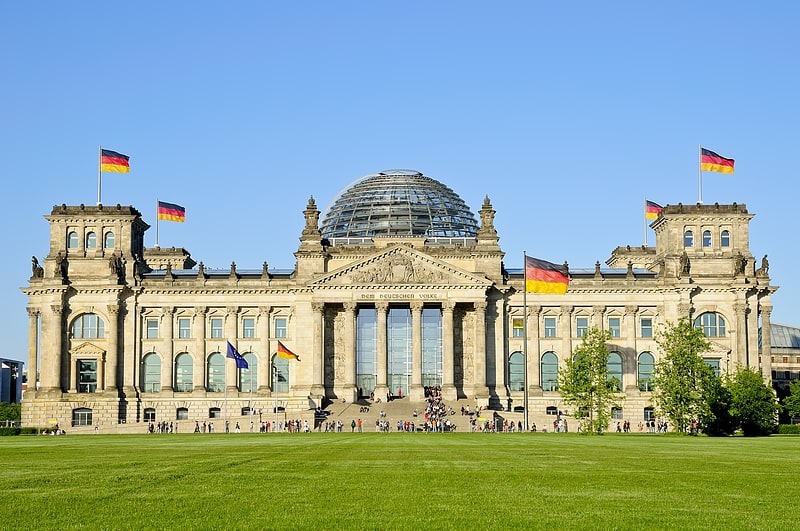
Historic, glass-domed home of parliament. The Reichstag is a historic building in Berlin which houses the Bundestag, the lower house of Germany's parliament.
It was constructed to house the Imperial Diet (German: Reichstag) of the German Empire. It was opened in 1894 and housed the Diet until 1933, when it was severely damaged after being set on fire. After World War II, the building fell into disuse; the parliament of the German Democratic Republic (the Volkskammer) met in the Palast der Republik in East Berlin, while the parliament of the Federal Republic of Germany (the Bundestag) met in the Bundeshaus in Bonn.
The ruined building was made safe against the elements and partially refurbished in the 1960s, but no attempt at full restoration was made until after German reunification on 3 October 1990, when it underwent a reconstruction led by architect Norman Foster. After its completion in 1999, it once again became the meeting place of the German parliament: the contemporary Bundestag.[26]
Address: Platz der Republik 1, 11011 Berlin (Mitte)
Schloss Friedrichsfelde
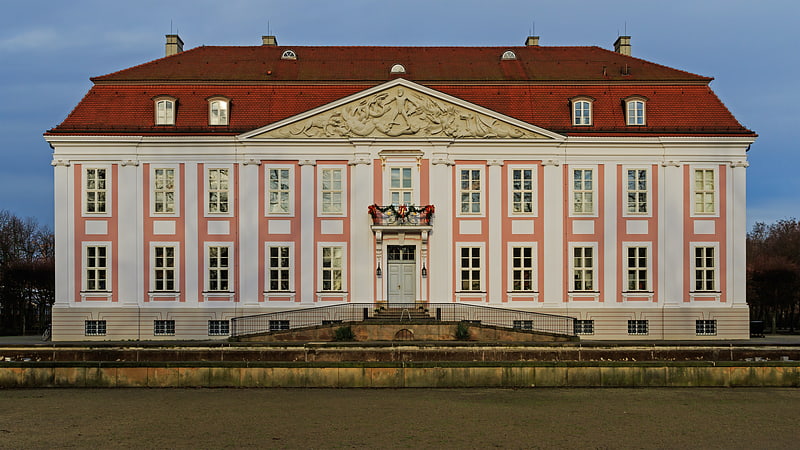
Building in Berlin, Germany. The Friedrichsfelde Palace is a Neoclassical-style building in the centre of the Tierpark Berlin in Berlin-Friedrichsfelde. It was property of various noble Prussians and occasionally owned by Prussian Kings. Currently, the palace offers exhibitions about its history and is a place for musical concerts.[27]
Friedrichstraße

Street in Berlin, Germany. The Friedrichstraße is a major culture and shopping street in central Berlin, forming the core of the Friedrichstadt neighborhood and giving the name to Berlin Friedrichstraße station. It runs from the northern part of the old Mitte district to the Hallesches Tor in the district of Kreuzberg.
This downtown area is known for its expensive real estate market and the campus of the Hertie School of Governance. Due to its north-southerly direction, it forms important junctions with the east-western axes, most notably with Leipziger Straße and Unter den Linden. The U6 U-Bahn line runs underneath. During the Cold War it was bisected by the Berlin Wall and was the location of Checkpoint Charlie.[28]
Bellevue Palace
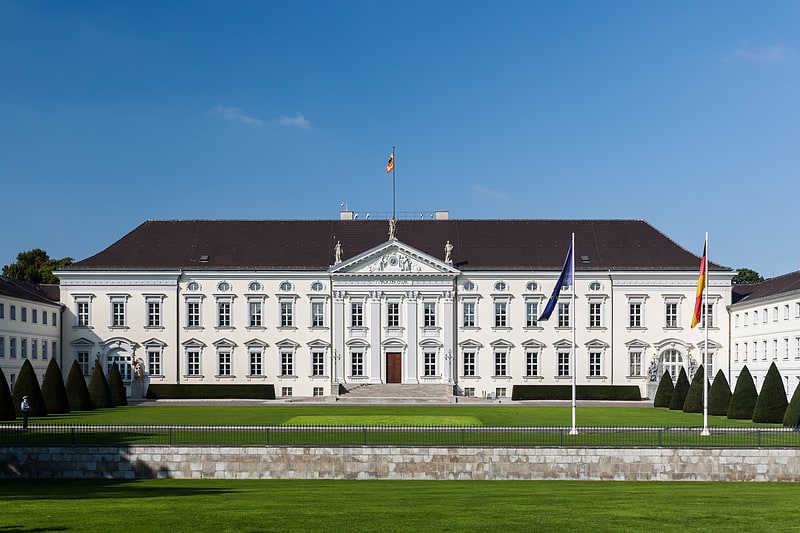
Also known as: Schloss Bellevue
Grand, classical presidential residence. Bellevue Palace, located in Berlin's Tiergarten district, has been the official residence of the President of Germany since 1994. The schloss is situated on the banks of the Spree river, near the Berlin Victory Column, along the northern edge of the Großer Tiergarten park. Its name – the French for "beautiful view" – derives from its scenic prospect over the Spree's course.[29]
Address: Spreeweg 1, 10557 Berlin (Mitte)
Ephraim-Palais
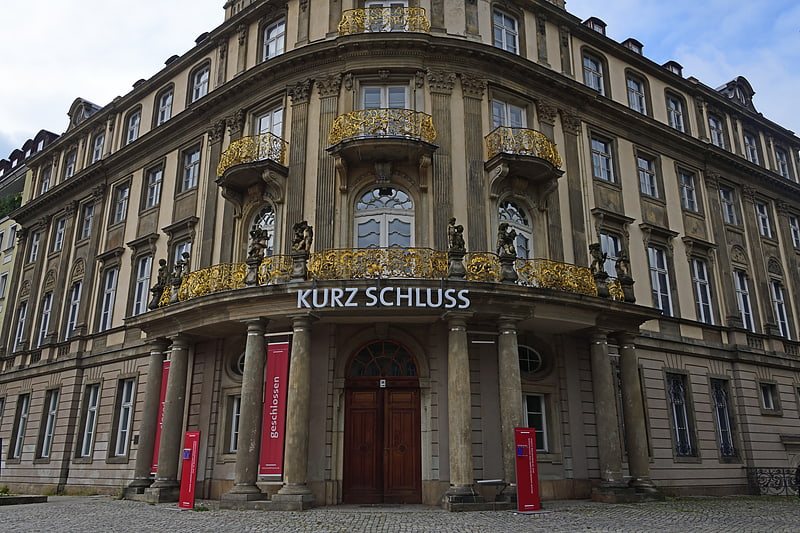
Museum in Berlin, Germany. The Ephraim Palace is a Rococo-style building in Berlin, Germany, originally constructed in 1766. Despite the destruction of the palace in 1936 by Nazi Germany, the beginning of a reconstruction was possible in 1985, as many elements of the facade had been stored in East Germany. Today, the Ephraim Palace is a cultural-heritage property and houses a museum, mostly dealing with cultural topics.
The Ephraim Palace is named after Veitel Heine Ephraim, who hired the experienced architect Friedrich Wilhelm Dieterichs to design a palace on the property of the oldest pharmacy of Berlin.[30]
Address: Poststr. 16, 10178 Berlin (Mitte)
Rotes Rathaus
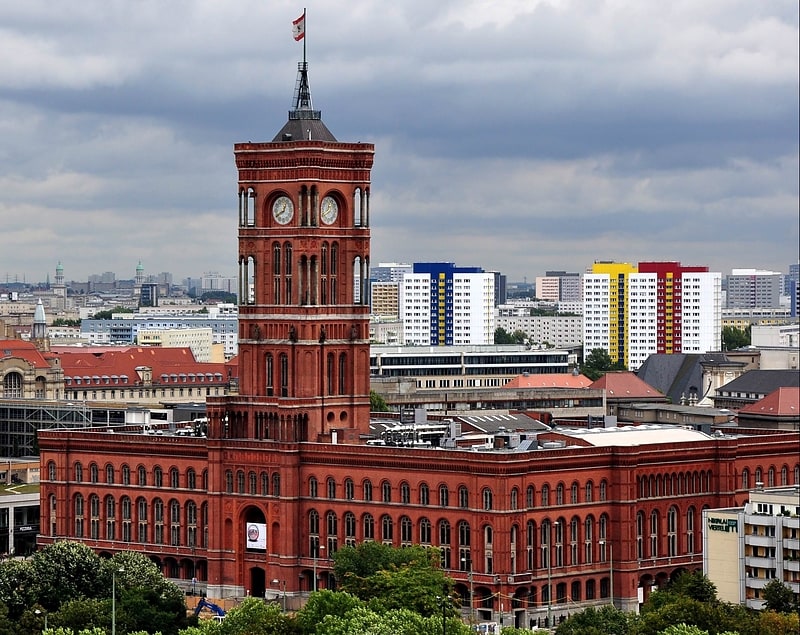
Imposing neo Renaissance town hall. The Rotes Rathaus is the town hall of Berlin, located in the Mitte district on Rathausstraße near Alexanderplatz. It is the home to the governing mayor and the government of the state of Berlin. The name of the landmark building dates from the façade design with red clinker bricks.[31]
Address: Rathausstraße 15, 10178 Berlin (Mitte)
Museum Island
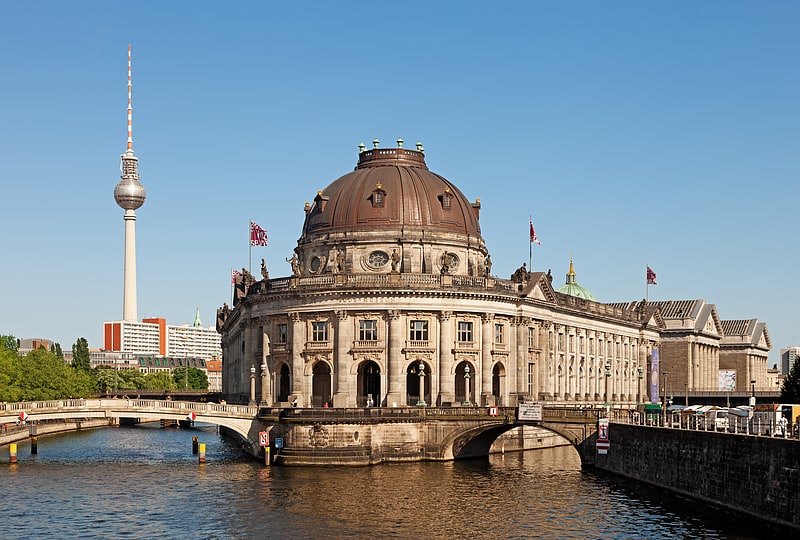
Also known as: Museumsinsel
Island in Berlin, Germany. The Museum Island is a museum complex on the northern part of the Spree Island in the historic heart of Berlin. It is one of the most visited sights of Germany's capital and one of the most important museum sites in Europe. Built from 1830 to 1930 by order of the Prussian Kings according to plans by five architects, the Museum Island was designated a UNESCO World Heritage Site in 1999. It consists of the Altes Museum, the Neues Museum, the Alte Nationalgalerie, the Bode-Museum and the Pergamonmuseum. As Museum Island includes all of Spree Island north of the Unter den Linden, the Berliner Dom is also located here, near the Lustgarten. To the south, the reconstructed Berlin Palace houses the Humboldt Forum museum and opened in 2020. Since the German reunification, the Museum Island has been rebuilt and extended according to a master plan. In 2019, a new visitor center and art gallery, the James Simon Gallery, was opened.[32]
Tränenpalast

Museum in Berlin, Germany. The Tränenpalast is a former border crossing point between East and West Berlin, at Berlin Friedrichstraße station, which was in operation between 1962 and 1989. It is now a museum with exhibitions about Berlin during the Cold War period and about the process of German reunification. It was the border crossing for travellers on the S-bahn, U-bahn and trains going between East and West Germany. It was used only for westbound border crossings. It had separate checkpoints for West Berliners, West Germans, foreigners, diplomats, transit travellers and East Germans.
The term Tränenpalast is derived from the tearful partings that took place in front of the building between western visitors and East German residents who were not permitted to travel to West Berlin.[33]
Address: Reichstagufer 17, 10117 Berlin (Mitte)
DDR Museum
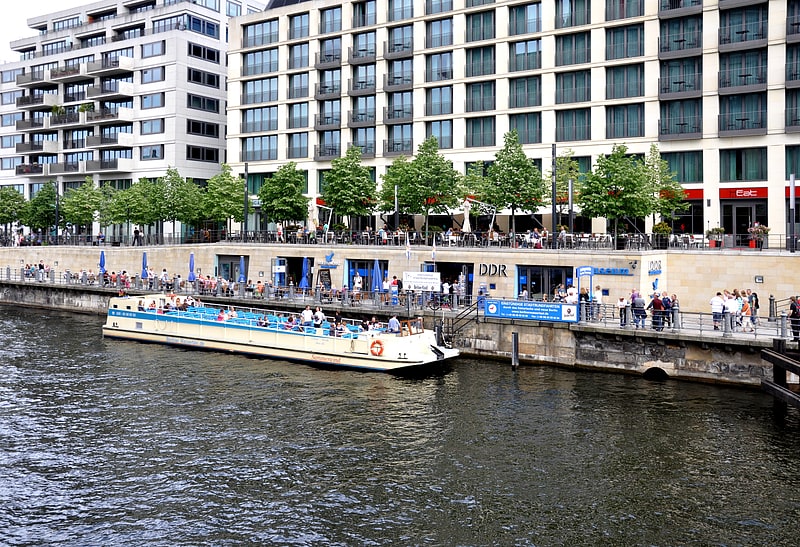
Interactive museum of East German life. The DDR Museum is a museum in the centre of Berlin. The museum is located in the former governmental district of East Germany, right on the river Spree, opposite the Berlin Cathedral. The museum is the 11th most visited museum in Berlin.
Its exhibition depicts life in the former East Germany (known in German as the Deutsche Demokratische Republik or DDR) in a direct "hands-on" way. For example, a covert listening device ("bug") gives visitors the sense of being "under surveillance". One can also try DDR clothes on in the recreated tower block apartment, change TV channels or use an original typewriter. The exhibition has three themed areas: “Public Life”; “State and Ideology” and “Life in a Tower Block”. Each of them is presented under a critical light: the positives as well as the negatives sides of the DDR are explored in this exhibition. A total of 35 modules illustrate these three themes: Media, literature, music, culture, family, private niche, health, equality, diet, childhood, youth, partnership, fashion, border, Berlin, tra c, education, work, consumption, construction, living, free time, vacation, environment, party, Ministry for State Security, economy, state, ideology, army, brother states, wall, opposition, penal system and authority.
The museum was opened on July 15, 2006, as a private museum. Private funding is unusual in Germany, because German museums are normally funded by the state. The museum met some opposition from state-owned museums, who considered possibly "suspect" a private museum and were concerned that the museum could be used as an argument to question the public funding of museums in general.
In 2008, the DDR Museum was nominated for the European Museum of the Year Award.[34]
Address: Karl-Liebknecht-Str. 1, 10178 Berlin (Mitte)
Glienicke Palace
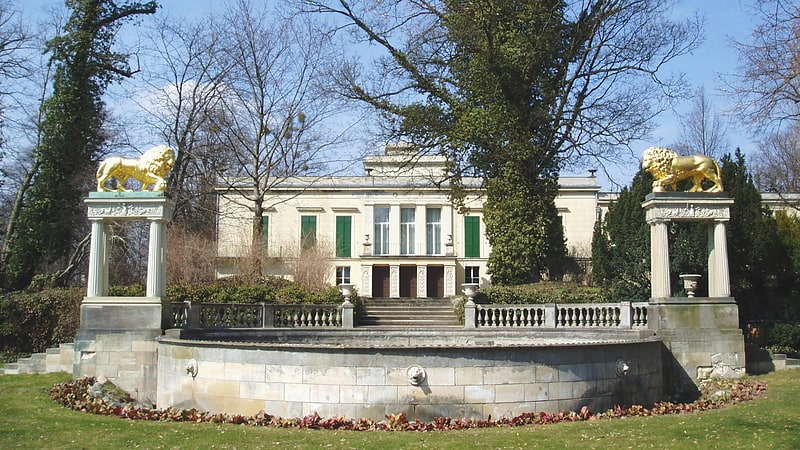
Also known as: Schloss Glienicke
Palace in Berlin, Germany. Glienicke Palace is a historic palace located on the peninsula of Berlin-Wannsee in Germany. It was designed by Karl Friedrich Schinkel around 1825 for Prince Carl of Prussia.[35]
Address: Königstraße 36, 14109 Berlin (Steglitz-Zehlendorf)